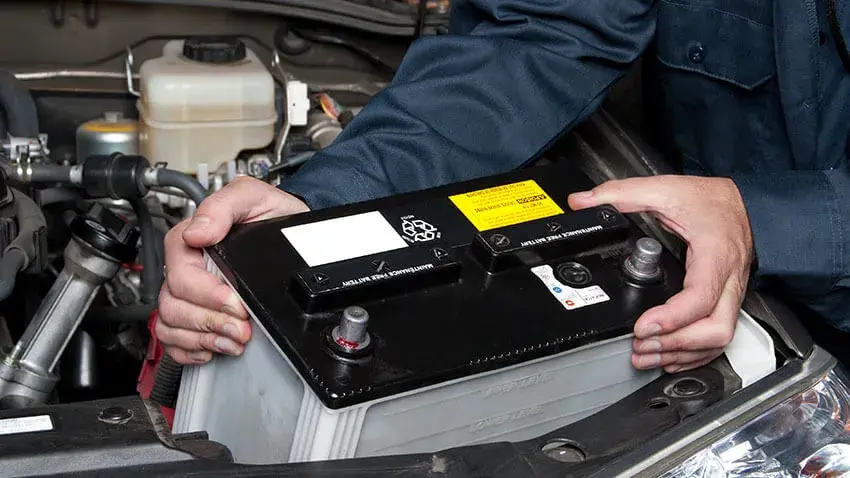
Safety notice
While it is unlikely that you will receive a shock from a 12 volt car battery, there are still potential safety hazards involved.
- Battery acid or residues leaking from a battery can be irritant or corrosive.
- Some batteries may release hydrogen gas which can be ignited by sparks
The following precautions are recommended when handling or working on batteries:
- Wear gloves to protect skin from harmful chemicals.
- If you clean terminals with a brush, wear goggles to ensure particles of residue don't get flicked into your eyes.
- Ensure the area is well ventilated to prevent a buildup of gas that may be ignited by sparks.
Unsung hero
Your car's battery is one of the consumable parts that's easiest to forget about until it lets you down. For the most part, a battery will last for between three and six years, even if you do nothing to maintain it in good order. That said, it's best to do what you can to get the most from it - even if that's just cleaning it occasionally. Regular checking and charging when necessary can help maximise a battery's life. Depending on the battery type and make, the conditions in which you drive and other factors, some batteries will last far longer than average.
Warning signs
Issues are most likely if your battery is more than about four years old. Possible signs of a deteriorating battery are:
- The engine stalls increasingly often.
- The engine labours to turn over, or does so sluggishly.
- The car is slow to start.
- The car needs jump starting sometimes.
- Internal end/or external lights dim or flicker.
- Electrical items such as windows, door mirrors etc seem slow or unreliable.
- There's an unpleasant "eggy" smell from the battery.
- The battery is swollen or bulging.
- The terminals look mucky or there is a buildup of residue there. If this is the case, you could try cleaning the terminals to see if that solves or mitigates the issues. Some dirt or residues can prevent the battery connections from making good electrical contact.
Some electrical problems may be caused by a faulty alternator - the part that is responsible for keeping your battery charged by the engine. It can be tricky to tell which is the culprit, so you may wish to ask your mechanic to check it out, just to be sure whether the issue is with the alternator, the battery, or some other part of the electrical system.
How do I know which battery I need
Your car's owner's manual should give details of the required spec. If in doubt, consult your car dealer or mechanic.
A simple way to find an appropriate battery for your car is to use one of the many online battery-finders offered by battery specialists and automotive retailers. Most of these battery-finder tools will simply ask for your car's registration number and then it will match your car's make and model with a selection of appropriate batteries. You can select your new battery according to price, manufacturer, estimated lifespan and length of guarantee.
How to change your battery
Removing your old battery
-
Find the battery
In a normal petrol or diesel car, the battery is in the engine compartment. It is a grey or black block about the size of a shoebox. It has two terminals to which cables will be attached with clamps.
-
Disconnect the cables from the negative terminal of the battery
The terminals may be marked + for positive and - for negative. The cable going to the positive terminal will usually be red or partly red, and there may be a red cap covering the terminal. The negative terminal, which we will disconnect first, will have a black cable connected and/or an uninsulated, braided wire strap.
You will need a spanner or wrench of the correct size or type to loosen the nut on the connector.
Tuck the disconnected cables out of the way so they don't accidentally touch the terminals.
-
Disconnect the cables from the positive terminal
and tuck them out of the way.
-
Loosen the battery retaining clamp
Take care not to drop any nuts, bolts or screws into the engine compartment. If you need to fully remove any nuts, bolts or screws, put them in a pocket or somewhere safe so you don't mislay them. Your new battery must be firmly secured before you drive.
-
Remove the old battery
Place it somewhere where children and pets won't get at it. Take care lifting and handling the old battery as they can be surprisingly heavy.
-
Clean the battery tray and the terminals
Fitting your new battery
-
Put in your new battery
Place your new battery in the battery tray, ensuring the terminals are the same way around as they were on the old battery, and that you know which terminals the red and black cables should go to.
Secure the battery with the battery retainer clamp.
-
Reconnect the terminals
Connect the positive (red cable) first and tighten the connector firmly to ensure a good connection.
Reconnect the negative cables to the negative terminal and tighten the connector.
-
Check the connections a final time
And then test everything by starting the engine.
A note about disposal of your old battery
Car batteries contain harmful substances such as lead and acid. Don't leave old batteries lying around in garages etc: they can leak and they can emit flammable gas.
Most local authority recycling centres will have facilities to take your old car battery.
